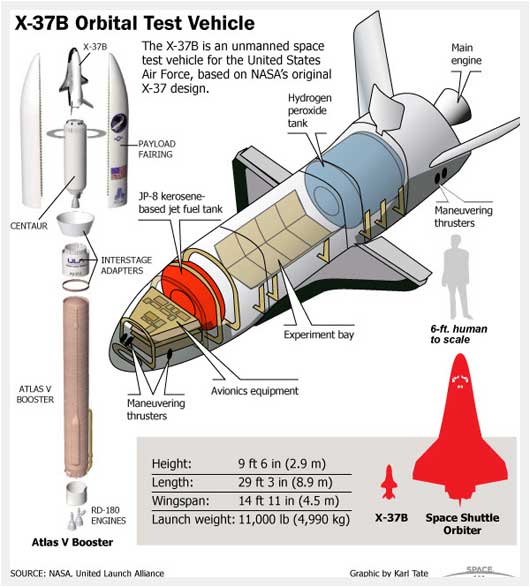Getting To Know Discovery’s Runt Cousin: The Air Force X-37B
 Wednesday, March 2, 2011 at 09:28PM
Wednesday, March 2, 2011 at 09:28PM Watch the X-37B (Atlas V) launch March 4, 2011 at ulalaunch.com
(launch period begins at 3:39pm EST)
 Fast facts on the Boeing X-37B unmanned OTV (Orbital Test Vehicle)
Fast facts on the Boeing X-37B unmanned OTV (Orbital Test Vehicle)
With the Space Shuttle program only one landing and two full flights away from retirement, and with the Constellation manned program effectively pulled over to the side of the road, we’re likely to see a lot more emphasis on unmanned space vehicles. It’s interesting that as unmanned aircraft are just now becoming a significant part of aviation, ‘unmanned’ space vehicles have been part of space exploration for decades. Sure, it’s a little different controlling a flying machine in the atmosphere with real people for traffic compared to coasting along in the vast expanse of space with no one around, but expanding our efforts in space with more emphasis on machines-only isn’t such a bad idea.
Enter Boeing’s X-37B Orbital Test Vehicle operated by the U.S. Air Force. This very scaled down shuttle-like spacecraft is only a little over 29 feet long with a wingspan just short of 15 feet, but it’s still likely to be a pretty capable spaceplane. If only we really knew what it was being used for. That seems to be a bit of a mystery yet. And while it’s easy to imagine all kinds of shifty covert intentions, I must admit that I’m glad to know it exists and is operational in light of the fact that Shuttle is almost retired.
This is also a very interesting time as the second ever space flight for the X-37B is scheduled to launch out of Cape Canaveral on top of an Atlas V rocket on March 4, 2011. It’s actually the first flight for this particular vehicle, OTV-2, the second airframe to be built. The timing seems to fuel some thoughts about the fact that both Shuttle Discovery and the X-37B will be in space at the same time. Coincidence? You decide.

One of the two X-37B OTV's built thus far
The first spaceflight for the X-37B launched back on April 22, 2010. It remained in space until December 3, 2010, when it returned for landing at Vandenberg AFB in California. Check out the nighttime video of the OTV-1 landing at page bottom. Not a lot to see, but it apparently went very well, tho it did blow a tire on the landing. No serious damage resulting. Most interesting is the fact that the X-37B is autonomous, so once it’s configured for landing, the machine itself is in control. We’re seeing a lot more expansion into autonomous unmanned flying machines here lately, and so far with great success… the X-47B UCAV that’s intended to eventually operate off of Navy carriers made its first flight on February 4, 2011. I’m currently in favor of autonomous unmanned aircraft over the old-fashioned way of having a human sit at a ‘pilot station’, but that could all change if we ever see a very undesirable result from a machine gone mad.

 OTV-1 after landing at Vandenberg AFB on December 3, 2010
OTV-1 after landing at Vandenberg AFB on December 3, 2010
Here the X-37B is seen shortly after the first spaceflight landing. Apparently the spaceplane encountered some space junk on that 244 day mission, resulting in 7 dents to the airframe. None created any serious damage tho. This thing is expected to reach speeds of up to Mach 25 on re-entry, and when coupled with long missions in space, the airframe is likely to get a real workout. It would seem this is one of the real areas of research for the craft… to better understand what is needed to produce a reliable long-term, high mileage re-usable spacecraft.
The lower picture with the ground crew visible helps to give some scale to the OTV. As is common with spacecraft, the personnel wear a SCAPE (Self-Contained Atmospheric Protective Ensemble) until it's determined that there are no leaks of any potentially hazardous materials.

The Atlas V booster used to launch the X-37B
The X-37B is launched via the Atlas V booster as seen above. The Atlas V can be launched from either Cape Canaveral or Vandenberg, tho Cape Canaveral has been the launch site for both the first and now this second scheduled launch. The OTV is carried inside the bulbous nose cone of the Atlas V. The first picture, at the top of the post, gives a good view of how the vehicle is stowed inside the payload section.
The upcoming launch is scheduled for Friday March 4th and the launch period opens at 3:39pm EST. If the lunch is scrubbed, the next attempt will be on the following day, March 5. The launch is expected to be viewable at the United Launch Alliance website at ulalaunch.com. I know I’m planning to check it out… I hope you get the chance too. Then we can both spend some time imagining what kind of Star Wars mission this bugger is on!
X-37B landing in December 2010. Not a lot to see, but still interesting.














































































Reader Comments (1)
The X-37C is now being proposed by Boeing. It is an upscaled version of the X-37B designed to carry astronauts. Funding will be the main issue of course on weather it is developed and flown. It looks cool and represents our best hope of reviving a shuttle program again for NASA.